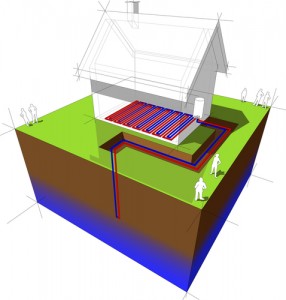The Benefits of Geothermal Systems for Homeowners
Geothermal systems are one of the most efficient and environmentally friendly heating and cooling systems you can have in your home, and they’re becoming more common all the time. But what exactly are geothermal systems? What benefits can geothermal systems give homeowners? Read on for the answers to these questions and more, brought to you by the HVAC professionals at Lancaster Brothers Heating and Cooling.
What Is Geothermal Energy?
Geothermal energy is heat derived from harnessing the earth’s heat from underground. Not far beneath the earth’s surface, the temperature remains constant, as opposed to the seasonal temperature swings that occur above ground. Water and steam carry the geothermal energy to the earth’s surface, which can be used for heating and cooling purposes.
A geothermal comfort system for heating and cooling your home puts this technology to work by means of a geothermal heat pump that is buried underground. Geothermal piping is buried deep in the ground, either vertically or horizontally, depending on the yard size of the home. Geothermal heat pumps can also harness heat from bodies of water, such as a pond or lake, or can use groundwater from a well, depending on what is available on the property.
Environmental Impact
Geothermal energy does not burn a fuel source and therefore does not release emissions, making it a clean and renewable energy source for heating and cooling your home. By tapping into the renewable energy beneath the earth’s surface homeowners can save money and reduce their carbon footprint. For heating and cooling a home or business, these systems are considered the most environmentally friendly. EnergyStar rated and approved by the U.S. Department of Energy, geothermal systems are becoming an increasingly popular choice of homeowners for heating and cooling.
Types of Geothermal Systems
Geothermal systems can be closed-loop or open-loop. Closed-loop geothermal systems circulate liquid through a “loop system” of small-diameter, underground pipes. These pipes can be installed horizontally, vertically or in a pond. In open-loop systems, heat is transferred to or from your home using either a well or surface water, providing comfortable temperatures to your home year round, regardless of the outside temperatures. The majority of geothermal installations in the Kansas City area are a vertical, closed-loop system, where we drill deep into the ground to install the geothermal piping.
Save Money With Geothermal Energy
A geothermal system can save you money in several different ways, including the following:
Lower Energy Bills – Though they may be expensive initially, when one compares the long term return on investment with heating and cooling, geothermal systems save a household more in the long run. After 5-7 years, the unit usually pays for itself by way of monthly savings on the energy bill. The total energy consumed can be cut as much as 44%.
Longer Lifespan and Low Maintenance – Geothermal comfort systems have longer lifespans and require less maintenance than traditional HVAC systems. The indoor components are simple to repair and last on average 24 years. The units also last longer than conventional installations. They contain fewer moving parts, are constructed of more durable components, and are housed in a more protected enclosure. This means less maintenance on your system which saves you money on repairs. The indoor components typically last 24 years or more, while the outdoor components, including the ground loop, tend to last 50 years or more. This results in significant savings in both the short- and long-term.
Tax Credits – Because geothermal energy is clean and energy efficient, the federal government has offered a 30% tax credit for installations of ground source heat pumps. If you install a geothermal comfort system in a new construction home or replace the system in your current home, you can claim this generous tax credit through 2032. There is currently no upper limit on the credited amount, so you will be able to offset 30% of the total cost of installation. It’s important to remember that geothermal equipment must meet the Energy Star program requirements to qualify for the tax credit.
Professional HVAC Installation
Lancaster Brothers Heating and Cooling are the experts in the Kansas City area for installing geothermal systems. We have been the top HVAC specialists in the area for over 22 years and have installed hundreds of geothermal heat pumps for our customers. If you are interested in a geothermal system for your home in the Kansas City area, call Lancaster Brothers to schedule a time for us to come to your home and give you an estimate. Our geothermal heating and cooling experts can be reached by calling (913) 851-3399 or contact us via our website.
admin October 10th, 2022
Posted In: Geothermal
Tags: geothermal hvac
5 Tips to Make It through Summer with a Struggling Air Conditioner
 Air conditioner problems aren’t usually at the forefront of your mind. A great AC just works. It keeps you in comfort and lets you go about your daily life…until it doesn’t. Most homeowners know when it’s time to replace their air conditioner. There are signs that let them know they are sitting on a ticking time bomb. But let’s face it, no one wants to buy a new air conditioner if they can squeak one more year out of the old one. So here are 5 tips from the AC pros at Lancaster Brothers for making it through the summer with an aging AC.
Air conditioner problems aren’t usually at the forefront of your mind. A great AC just works. It keeps you in comfort and lets you go about your daily life…until it doesn’t. Most homeowners know when it’s time to replace their air conditioner. There are signs that let them know they are sitting on a ticking time bomb. But let’s face it, no one wants to buy a new air conditioner if they can squeak one more year out of the old one. So here are 5 tips from the AC pros at Lancaster Brothers for making it through the summer with an aging AC.
1. Set Your Expectations a Little Lower
On super hot days, your old AC may not be able to keep your home comfortable. If it’s 100 degrees, your home may stay in the upper 70s to 80 degrees. Even brand new air conditioners can only support a maximum temperature drop of about 20 degrees Fahrenheit between supply and return air (although it will likely be a bit lower since your indoor return air is usually cooler than the air outside).
2. Expect to Pay for Refrigerant
If your AC is older, chances are it runs on Freon. Since Freon was banned by the EPA (because it damaged the ozone layer) and is no longer being manufactured, the price has skyrocketed as demand has built and supply has decreased. If your system leaks refrigerant, more will have to be added to allow it to be able to keep your home cool. It will cost hundreds to recharge your system and leaks are very difficult to locate and fix. If you are paying for Freon, most likely you will continue paying for it until you replace your system. Newer systems use R410a, an environmentally safe refrigerant that costs much less. Unfortunately, older units are not designed to use the newer refrigerants.
3. Expect Higher Energy Bills
An older system won’t run as efficiently as a new one. New air conditioners are much more efficient by design, but an older system is not only built with less efficiency in mind, but also parts are older, connections are weaker, the system is dirtier, and most just don’t run smoothly or quietly anymore. The harder your AC has to work, the longer it will have to run to reach the temperature on the thermostat and the higher your electric bills will be.
4. Get a Tune-Up
A tune-up on an older system is a great idea. Not only will it help it run more efficiently, it will reduce the number of unwanted breakdowns and emergency service calls. It may be what gets your AC through the season. A technician will replace any worn parts, check all electrical connections, lubricate any moving parts, clean your system and repair any broken parts. Simply cleaning your air conditioner will help it run more efficiently too.
5. Change the Filter Monthly
A dirty filter will impede your system’s ability to push air through it, making it work harder and cost more. Make sure to change your filter every month. You’ll have cleaner indoor air too!
How to Decide Whether a Repair Is Worth It
If your air conditioner breaks down, the immediate question is: do you repair it again or do you replace it entirely? Thankfully, there’s a simple way to figure out which way to go. It’s called “the $5,000 rule”: It’s simple. Note the age of your AC and multiply the age by the amount of your most recent repair bill. If this results in a number less than $5,000, a repair is likely the best way to go! Of course, this is meant as a first step; a professional consultation from a trusted repair provider is another great data point to gather. But the decision is ultimately yours, and this is a great way to pin down what might be the best way to spend your money in the long run.
How to Know When It’s Time to Replace Your AC
The formula above is a start, but a few extenuating circumstances mean you might be better off with a full replacement anyway.
- Three repairs over the course of three years is a red flag. This implies a larger issue that a fourth repair might not address fully.
- If your energy bills remain exceedingly high after a repair, that’s another major warning sign that the overall health of your AC system is ailing.
- And finally, post-repair Freon leaks after multiple repairs implies that patching it up and refilling it yet again will not solve the systemic issues with your AC.
Don’t Wait Until Your AC Breaks This Summer to Replace Your Air Conditioner
 Your local Kansas City HVAC professionals at Lancaster Brothers are always happy to help! We’re here for cultivating long-term relationships with our customers, not to upsell, so after you’ve thought about whether you think you need a repair or replacement, we can definitively point you in the right direction.
Your local Kansas City HVAC professionals at Lancaster Brothers are always happy to help! We’re here for cultivating long-term relationships with our customers, not to upsell, so after you’ve thought about whether you think you need a repair or replacement, we can definitively point you in the right direction.
Call us today at (913) 851-3399 or contact us online. If you do decide to replace, we can offer a great deal on a quality Lennox system.
Chris Lancaster May 8th, 2018
Posted In: Cooling, Geothermal, Maintenance
Tags: AC Maintenance
How to Set Your Programmable Thermostat for the Biggest Savings
 Utility bills are the biggest expense most households incur. According to the latest statistics (Dec. 2017) from Expatistan, an international cost of living website, the average price of utilities for one month (heating, electricity, gas…) for 2 people in 900 sq. ft. home in Kansas City, Missouri is $230. Multiply that by 12 and it’s approximately $2,760 per year. The larger the home, the larger the utility bills. Reducing your utility bill is one of the best ways to put a significant amount of money back into your pocket. The good news is, it’s easy to do with a programmable thermostat.
Utility bills are the biggest expense most households incur. According to the latest statistics (Dec. 2017) from Expatistan, an international cost of living website, the average price of utilities for one month (heating, electricity, gas…) for 2 people in 900 sq. ft. home in Kansas City, Missouri is $230. Multiply that by 12 and it’s approximately $2,760 per year. The larger the home, the larger the utility bills. Reducing your utility bill is one of the best ways to put a significant amount of money back into your pocket. The good news is, it’s easy to do with a programmable thermostat.
The team at Lancaster Brothers Heating and Cooling has put together this simple tutorial on how to save as much as 10% a year on heating and cooling by simply using your programmable thermostat. The Department of Energy reports that turning your thermostat back 7°-10°F for 8 hours a day from its normal setting will save you up to 10%. If you live in a 900 sq. ft. home, this means you save about $276! Read on to learn the secrets to saving big.
How Do I Program My Thermostat to Save Money?
Since you don’t need to heat or cool your home as much while you are away at work or sleeping, those are the times to lower or raise the temperature to reduce the amount of energy you use. The good news is, you won’t even notice! Here are some simple guidelines for year-round programming:
Winter Settings – for the winter months, we suggest setting the thermostat to 72 degrees Fahrenheit while you’re awake, and set it seven to ten degrees lower while away or asleep.
Summer Settings – for the summer months, set the thermostat for 72 degrees Fahrenheit when you are at home and warmer than normal while you are away. We suggest that you set your thermostat up no more than five degrees at any point in time. With the open floor plans of modern homes today, the volume of space your air conditioner is trying to condition makes it counterproductive because it’s too hard for your system to catch up on really hot days.
Tips for Choosing a Programmable Thermostat
If you don’t yet own a programmable thermostat, you’ll find there are a lot of choices out there. Here are some tips for purchasing a programmable thermostat. Some of the features to consider include:
- User-friendly digital displays so you can easily preset the temperatures for different parts of the day.
- Wi-Fi compatibility. Homeowners are able to adjust the settings using a computer, tablet, or smartphone.
- Alerts for changing the filter in your HVAC unit.
- Allow manual overriding of a setting without losing preset programming.
- Programs that differentiate between weekdays and weekends.
If you need help installing a new programmable thermostat, just give Lancaster Brothers a call.
Lennox Makes a Wide Variety of Programmable Thermostats
 We are proud to install Lennox brand furnaces and air conditioners, and when you install a programmable thermostat, you are sure to gain the most efficiency you can from your new heating and cooling system. Lennox makes a wide variety of programmable thermostats. If you need help choosing one, give us a call and our comfort specialists can give you all the details.
We are proud to install Lennox brand furnaces and air conditioners, and when you install a programmable thermostat, you are sure to gain the most efficiency you can from your new heating and cooling system. Lennox makes a wide variety of programmable thermostats. If you need help choosing one, give us a call and our comfort specialists can give you all the details.
If you’re ready to make the switch to a programmable thermostat and keep a few hundred more dollars in your pocket each year, contact us and let our dedicated and knowledgeable technicians install one for you today! Or call us at (913) 270-0698.
Chris Lancaster December 12th, 2017
Posted In: Cooling, Geothermal, Heating, Indoor Air Quality
Tags: heating facts, thermostats
News from Underground – Tax Credits of 30% on Geothermal Systems Expiring!
 Although the benefits of heating and cooling homes with geothermal energy don’t receive the same amount of publicity as solar heating, it just may be that still rivers run deep. The team at Lancaster has put together this update on geothermal systems to let you know about all of the benefits available, including huge tax benefits.
Although the benefits of heating and cooling homes with geothermal energy don’t receive the same amount of publicity as solar heating, it just may be that still rivers run deep. The team at Lancaster has put together this update on geothermal systems to let you know about all of the benefits available, including huge tax benefits.
Geothermal Provides Incredible Efficiency
Let’s start with the unparalleled cost-saving effect using geothermal energy has on heating and cooling bills. As the name suggests, geothermal comfort systems utilize the heat residing deep within the earth to maintain optimum temperatures in homes. They transfer energy rather than burning fuel. Because of this, the most efficient geothermal furnaces have received an efficiency rating of up to 41 EER.
Geothermal Is Environmentally Friendly
And since no matter is destroyed no polluting gases are created. Geothermal emits neither carbon dioxide, carbon monoxide, nor any other greenhouse gas. As a result, both the United States Department of Energy (DOE) and the Environmental Protection Agency (EPA) have recognized geothermal energy as the most environmentally beneficial way to heat and cool homes.
Geothermal Systems Are Whisper Quiet
The quiet operation of geothermal comfort systems are as friendly to the ears as they are to the environment. The ground loops that circulate and deliver the heat are buried deep within the earth and deliver heat directly to the home so there are no noisy outdoor air conditioning units or heat pumps like conventional systems require.
The Longest Lifespan of Heating & Cooling Systems
Since geothermal systems are not subject to the year-round whims of Mother Nature, they last longer. The average heat pump system lasts most homeowners an average of 13 years. Contrast that with the 24+ year lifespan of a geothermal system. In fact, most of the ground loops are made of the same propylene material that goes into city pipe lines, and carry a 50-year material warranty.
Related Read: How Many AC Repairs Are Too Many?
Tax Credits Are Set to Expire in 2016
Last, but certainly not least, there are the financial reasons to install a geothermal system:
- Energy Savings of up to 70% – The savings in energy will offset the initial installation investment. Geothermal systems have been found to reduce monthly bills by as much as 70%, and total energy consumption by 44%.
- ROI – Depending on individual usage, most geothermal systems can be expected to pay for themselves in reduced heating and cooling bills within a 5-to-7 year time span, while the energy savings continue for years and years.
- Tax Credits Expiring – As the icing on the cake, the government is so appreciative of the fact that more homeowners are turning to this win-win manner of heating and cooling that they are offering a 30% tax credit for installations. You can claim this generous tax credit whether you are building a new home or replacing the heating system in your current one. Since there is no upper limit on the credited amount, you will be able to offset the entire cost of installation by 30%. But, the tax credit is set to expire at the end of 2016. Your system must be installed by Dec. 31, 2016. So if you’ve been wavering over whether or not to install a geothermal system, there’s no time like the present to act.
Contact us now at 913-851-3399 to get a free-home estimate and have all your particular geothermal benefits & tax credits questions answered.
Chris Lancaster August 17th, 2016
Posted In: Geothermal
Geothermal Savings for Homeowners
 Over the years Lancaster Brothers Heating & Cooling has spoken to many homeowners who were not sure what geothermal heating was. Not only is it great for energy savings, but you can also receive a tax credit with it! Lancaster Brothers Heating & Cooling is here to break down all of the details below.
Over the years Lancaster Brothers Heating & Cooling has spoken to many homeowners who were not sure what geothermal heating was. Not only is it great for energy savings, but you can also receive a tax credit with it! Lancaster Brothers Heating & Cooling is here to break down all of the details below.
How to Receive a Geothermal Tax Credit
By installing a geothermal heating system, homeowners will receive a 30% tax credit. Through the end of 2016, this 30% tax credit is available for qualified geothermal heat pump property, meaning that the system uses either groundwater or the ground as a thermal energy source to heat the unit or cools the unit by using thermal energy sink.
Keep in mind, the geothermal heating equipment must meet the Energy Star program requirements. The tax credit will allow you to save 30% on the price of any unit. For example, if your geothermal heat pump costs $27,000, the tax credit will save $8,100. The total cost of your heat pump will be $18,900.
Related Read: Household Heating Costs Predicted to be Lower in 2016
Why Use Geothermal Heating
Geothermal heating has a variety of benefits. The systems are durable, lasting far longer than the average traditional heating and cooling system. Did you know that heating and cooling systems last roughly eight to 10 years? However, a geothermal heating system can last anywhere from 25 to 50 years with proper maintenance.
Because the ground stays a relatively steady temperature throughout the year, geothermal heating systems can be used to keep your home comfortable all year round. During the wintertime, they transfer heat from the ground to your home. The process can be reversed to keep your home cool during the summertime.
(Curious about geothermal systems? Check out our website.)
While the initial install of a geothermal heating system can be more expensive than traditional systems, ultimately this technology can help homeowners save money. By taking a significant amount of work off of traditional heating and cooling systems, homes with geothermal systems save energy, and in turn, enjoy reduced utility bills.
If you’re interested in adding a geothermal heating system to your home, call Lancaster Brothers Heating & Cooling at (913) 837-2000 to speak with the geothermal specialists & see just how much you could save.
Chris Lancaster February 29th, 2016
Posted In: Geothermal
Tags: geothermal, tax credit
